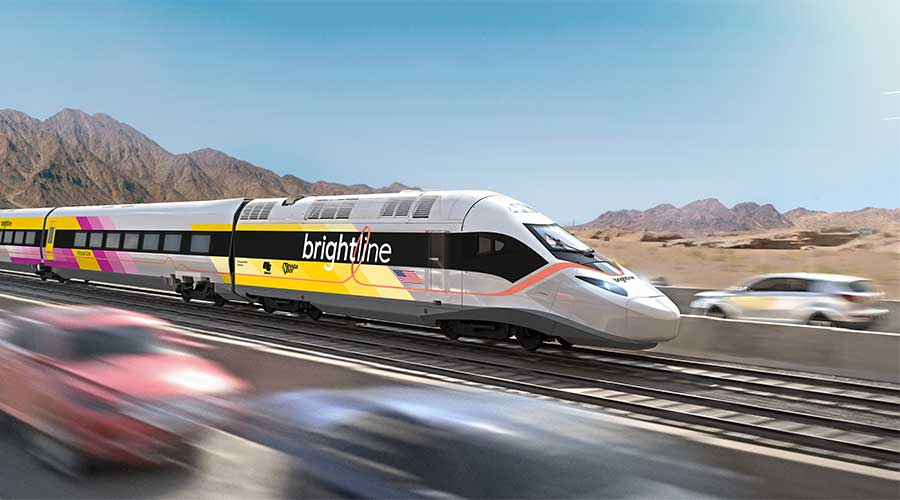Stay updated on news, articles and information for the rail industry
October 2010
Rail News: Passenger Rail
Passenger Rail at a Glance: Preface
by Angela Cotey, Associate Editor
In March, the American Public Transportation Association (APTA) issued a report analyzing the impacts the recession has had on public transit agencies. Member agencies were asked to detail the actions they had taken since Jan. 1, 2009, in response to the economic downturn, as well as actions they anticipated they'd take in the near future.
Of the 151 responding transit agencies (which carry more than 80 percent of all public transit riders in the United States), 90 percent reported flat or decreased local funding and 89 percent reported flat or decreased state funding. As a result, 84 percent of the responding agencies already had or planned to soon cut service or raise fares. In addition, more than half had eliminated positions and one in three had laid off employees.
The past year-plus has been a challenge, to say the least, but transit officials are no strangers to tough times.
"They are survivors," says APTA Vice President for Policy Art Guzzetti. "They're often expected to get through tough times, too often with resources that challenge them."
The short-term trends that are affecting agencies' budgets are direct impacts of the economic downturn. Long-term trends — such as population growth, increased demand for urban living, and energy and environmental pressures — will far outlast the negative impacts of the recession, says Guzzetti.
"Short term, the economy is sluggish, but the long-term trends point to continued [transit] growth," he says.
But for the time being, agencies continue to face budget pressures. In surveys submitted for Progressive Railroading's annual "Passenger Rail at a Glance" guide, many agencies cited budget issues, and subsequent fare hikes, service cuts and project delays as their biggest issues right now.
The Chicago Transit Authority (CTA) summed it up thusly:
"Like other transit agencies, CTA is challenged with meeting the increased demand for transit services while operating an aging transit system fraught with budget issues," an authority official wrote in response to a question asking what "hot issues" the agency was dealing with. "Due to the sluggish economy, revenue has been lower than projected. CTA has implemented cost-saving measures; however, the agency still is facing financial challenges."
And not just on the operating side. The authority also has $10 billion worth of unmet capital needs. The system — built in 1892 — is in dire need of capital investments in order for the agency to continue providing "quality" service, CTA said in its survey.
A large budget shortfall has not impacted MTA New York City Transit's (NYCT) capital program yet, but "it certainly will if the economic climate does not improve," according to the agency's survey. However, NYCT has had to lay off hundreds of employees and reduce service.
In Crisis Mode
Two agencies in Pennsylvania say a statewide "transit funding crisis" has and will continue to affect their operating and capital programs. In April, the U.S. Department of Transportation rejected a plan proposed by the commonwealth to toll Interstate 80, freeing up funding typically reserved for maintaining the roadway for transit agencies.
As a result, the Port Authority of Allegheny County is facing a $47 million operating shortfall that could force the agency to cut 35 percent of its service, raise fares and lay off more than 500 employees. The Southeastern Pennsylvania Transportation Authority (SEPTA) had to cut $110 million from its FY2011 capital budget by deferring 22 projects, including station renovations, facility upgrades and new payment technology.
Instead, SEPTA has submitted an application to the federal government seeking $29.3 million for its fare-collection system in an attempt to move the project forward.
But obtaining a share of federal funds is no easy task. Competition for federal transit dollars is fierce, and available money is dwindling as Congress has yet to pass a multi-year surface transportation bill. SAFETEA-LU, which expired a year ago, has been extended to the end of 2010.
The Tri-County Metropolitan Transportation District of Oregon got a federal funding wake-up call earlier this year when the Federal Transit Administration announced it would commit to funding 50 percent of the agency's Portland-Milwaukie light-rail project, rather than the 60 percent TriMet had requested. As a result, the agency is working to scale back the project and/or seek additional funds to keep it on schedule for a 2015 opening, according to TriMet's survey.
How much longer the recession will continue to affect transit agencies remains to be seen. But despite the toll it's taken on agencies during the past two years, there are some signs that better days are coming.
Expansion Frame of Mind
At Virginia Railway Express, officials are beginning the procurement process for more rail cars, as well as looking at expanding service into Spotsylvania County and western Prince William County. And in St. Louis, area residents in April voted to invest more money in public transit. St. Louis Metro has begun a service restoration program after slashing service in 2009 and is looking at expanding service in the coming years, according to the agency's survey.
Meanwhile, the national intercity passenger railroad is gearing up to be a player in the high-speed (and higher-speed) rail evolution. Amtrak has established a new department to pursue opportunities to develop new service in select corridors and improve service along the Northeast Corridor.
Perhaps the biggest sign that a transit — and, therefore, economic — recovery might be coming? In the second quarter, public transit ridership increased for the first time in six quarters, totaling 2.5 billion trips, according to APTA.
"History shows that as the economy grows, public transit ridership tends to increase," said APTA President William Millar in a prepared statement. "This rise in ridership offers a glimmer of hope that we may be coming out of the economic recession and ridership will continue to move upward."
In the meantime, transit agencies are plugging away on projects and initiatives that have made the cut.


 2025 MOW Spending Report: Passenger-rail programs
2025 MOW Spending Report: Passenger-rail programs
 Gardner steps down as Amtrak CEO
Gardner steps down as Amtrak CEO
 Guest comment: Oliver Wyman’s David Hunt
Guest comment: Oliver Wyman’s David Hunt
 Women of Influence in Rail eBook
Women of Influence in Rail eBook
 railPrime
railPrime







